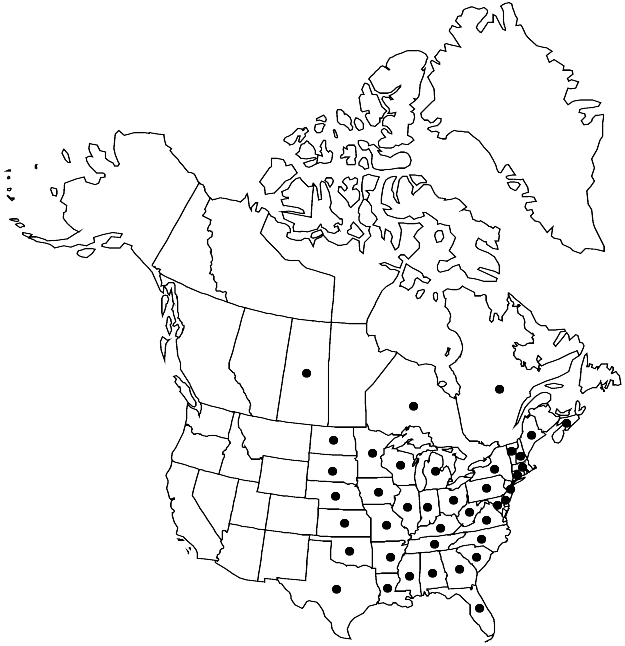Brachythecium acuminatum
Musci Appalach., 310. 1870.
Plants small, in loose to moderately dense mats, light green, yellowish, or whitish stramineous. Stems to 4 cm, creeping, terete-foliate, irregularly and often fasciculately branched, branches to 6 mm, straight, deviating from stem at acute angle, sometimes curving mid branch to almost perpendicular, terete-foliate. Stem-leaves erect-appressed, imbricate, ovatelanceolate, broadest at 1/7–1/5 leaf length, concave, not plicate or often with 2 ± distinct submarginal plicae, 1–1.6 × 0.3–0.6 mm; base slightly narrowed, short-decurrent; margins recurved proximally, plane or often recurved at places, serrulate distally or sometimes to base; apex gradually tapered or acuminate; costa to 60–80% leaf length, strong, terminal spine small or absent; alar cells subquadrate, same size as or smaller than basal-cells, 10–15 (–20) × 10–12 µm, walls moderately thick, region not clearly differentiated, of 6–8 (–10) × 4 (–6) cells; laminal cells linear, 40–80 × 5–7 µm; basal-cells 12–20 × 11–14 µm, region in 3 or 4 rows, moderately pellucid to opaque, markedly different from more distal cells. Branch leaves with margins more serrulate. Sexual condition dioicous. Seta redbrown, (0.7–) 1.5–2 (–2.5) cm, smooth. Capsule erect, redbrown, cylindric, straight or rarely slightly curved, 1.5–2.5 mm; annulus not separating; operculum conic, short-rostrate; peristome reduced; endostome basal membrane 1/4 endostome height, segments narrow, narrowly perforated, cilia absent or very short. Spores 12–19 µm.
Habitat: Tree trunks, bases
Elevation: low to moderate elevations (0-1500 m)
Distribution

N.S., Ont., Que., Sask., Ala., Ark., Conn., Del., Fla., Ga., Ill., Ind., Iowa, Kans., Ky., La., Maine, Md., Mass., Mich., Minn., Miss., Mo., Nebr., N.H., N.J., N.Y., N.C., N.Dak., Ohio, Okla., Pa., S.C., S.Dak., Tenn., Tex., Vt., Va., W.Va., Wis.
Discussion
The high variability of leaf length and shape in Brachythecium acuminatum led A. J. Grout (1928–1940, vol. 3) and H. Robinson (1962) to treat short-leaved plants as a separate species, B. cyrtophyllum, while the long-leaved were referred to B. biventrosum. H. A. Crum and L. E. Anderson (1981) found transitions between those extremes and synonymized the taxa with B. acuminatum. This broad circumscription is accepted here. Brachythecium acuminatum is sometimes difficult to distinguish from small forms of B. laetum, where leaves are only slightly plicate and the basal cells are not especially opaque and not especially pellucid. Branch leaves in these phenotypes are almost undistinguishable from leaves of B. acuminatum, and the dense branching may hide the stem leaves; however, the latter always have characteristic broad plicae on both sides of costa. Many keys, especially rather brief ones, describe B. acuminatum as a species with almost erect capsules. More expanded descriptions mention that the capsule is occasionally inclined to slightly curved; in exceptional cases it was observed to be inclined and almost horizontal. The numerous rows of basal cells and alar cells almost undifferentiated from basal juxtacostal cells are characteristic of this species.
Selected References
None.
Lower Taxa
"long" is not a number."concave" is not a number."broad" is not a number.